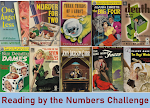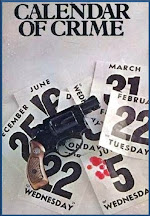 Glass on the Stairs (1954) is the third book by Margaret Scherf to
feature the husband and wife decorating team, Emily and Henry Bryce. This outing starts off with a bang--quite literally--when their downstairs neighbor Link Simpson (owner of a gun and antique shop) comes upstairs to ask Henry to help him deal with a hysterical woman who demands that he sell her a gun without a license. While Link is trying to convince Henry that it's his neighborly duty to help him out, they hear a shot and stumble down the stairs to find the woman dead and the gun near her hand.
Glass on the Stairs (1954) is the third book by Margaret Scherf to
feature the husband and wife decorating team, Emily and Henry Bryce. This outing starts off with a bang--quite literally--when their downstairs neighbor Link Simpson (owner of a gun and antique shop) comes upstairs to ask Henry to help him deal with a hysterical woman who demands that he sell her a gun without a license. While Link is trying to convince Henry that it's his neighborly duty to help him out, they hear a shot and stumble down the stairs to find the woman dead and the gun near her hand. Given Link's report of the woman's attitude prior to the shot and the evidence of more bullets in her purse, Burgeen (the police detective in charge of the case) decides that she must have come expressly to get her hands on a gun with which to commit suicide. Though, as Link says, why she did she have to kill herself in his shop? But the Bryces are always hoping for excitement and keep finding little clues that make them believe that Mrs. Otis Carver was murdered. There's the pink glove, the poisoned toothpaste, glass bits on the staircase, the sound that wasn't there, the mysterious awning fire, the scent of garlic, and the over-abundance of Lobelia (a nice little poisonous plant).
This is a fun little mystery. Lots of scattered sleuthing by Emily and false solutions galore before the end is in sight. Emily and Henry spend a lot of time rushing madly hither and yon in the attempt to track down clues. Henry spends a couple of afternoons wrangling with customs officials over an entirely extraneous couch which he has inherited--but the visits to various official offices gives him the opportunity to see one of their suspects behaving mysteriously, indeed. Emily blunders about telling everyone in sight about the (in her mind) oh-so-important clue of the pink glove. When Henry is attacked after finding it, it appears that Emily may be right. And then, of course, there's Henry's shoe-sniffing expedition. The Bryces make a welcome addition to the whimsical husband and wife detective teams--taking their place with the likes of Nick & Nora Charles and Pam & Jerry North.
The only down-side is, that despite the efforts of Emily and Henry to muddy the waters and spread suspicion everywhere, it shouldn't be all that difficult for astute readers to spot the killer fairly quickly. But the characters are interesting and the interactions of Emily and Henry with each other and the rest of the cast is so much fun that you won't really mind. ★★★ and a half.










































